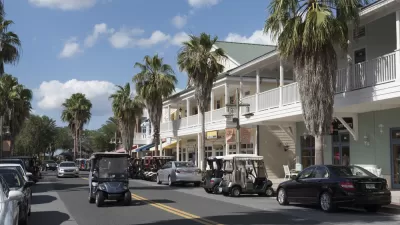Joel Kotkin and Alan M. Berger discuss their new book, which analyses what the suburbs are and will become, in both the United States and around the world.

A new book, Infinite Suburbia, edited by Joel Kotkin and Alan M. Berger, looks at suburbia from a variety of perspectives. At more than 700 pages, it is a collection of essays from the perspectives of architecture, planning, history, and transportation, to name a few. The Architect's Newspaper interviewed Kotkin and Berger about it.
In the interview, Kotkin is quoted:
"Two trends that may seem counterintuitive to urbanists have been the rapid pattern of diversification in suburbs, which now hold most of the nation’s immigrants and minorities, as well as the fact that suburbs are more egalitarian and less divided by class than core cities."
Kotkin and Berger point out that suburbs are not just diversifying, but that many U.S. central cities exhibit suburban land use patterns. Conversely, many cities around the world have suburbs with housing that is primarily multifamily and dense, a far cry from the transitional American single-family home and manicured lawn.
They point out that the future of suburbs will continue to be denser, but also more environmentally friendly. Suburbanites will demand fewer golf courses in the future and more public trails and common landscapes. They also believe autonomous cars will transform suburbia, and take strain off of transit systems so they can focus on improving service in urban cores rather than expanding outward in less efficient ways.
FULL STORY: What if Everything You Know About the Suburbs is Wrong?

Planetizen Federal Action Tracker
A weekly monitor of how Trump’s orders and actions are impacting planners and planning in America.

Congressman Proposes Bill to Rename DC Metro “Trump Train”
The Make Autorail Great Again Act would withhold federal funding to the system until the Washington Metropolitan Area Transit Authority (WMATA), rebrands as the Washington Metropolitan Authority for Greater Access (WMAGA).

DARTSpace Platform Streamlines Dallas TOD Application Process
The Dallas transit agency hopes a shorter permitting timeline will boost transit-oriented development around rail stations.

Renters Now Outnumber Homeowners in Over 200 US Suburbs
High housing costs in city centers and the new-found flexibility offered by remote work are pushing more renters to suburban areas.

The Tiny, Adorable $7,000 Car Turning Japan Onto EVs
The single seat Mibot charges from a regular plug as quickly as an iPad, and is about half the price of an average EV.

Supreme Court Ruling in Pipeline Case Guts Federal Environmental Law
The decision limits the scope of a federal law that mandates extensive environmental impact reviews of energy, infrastructure, and transportation projects.
Urban Design for Planners 1: Software Tools
This six-course series explores essential urban design concepts using open source software and equips planners with the tools they need to participate fully in the urban design process.
Planning for Universal Design
Learn the tools for implementing Universal Design in planning regulations.
Roanoke Valley-Alleghany Regional Commission
City of Mt Shasta
City of Camden Redevelopment Agency
City of Astoria
Transportation Research & Education Center (TREC) at Portland State University
US High Speed Rail Association
City of Camden Redevelopment Agency
Municipality of Princeton (NJ)





























